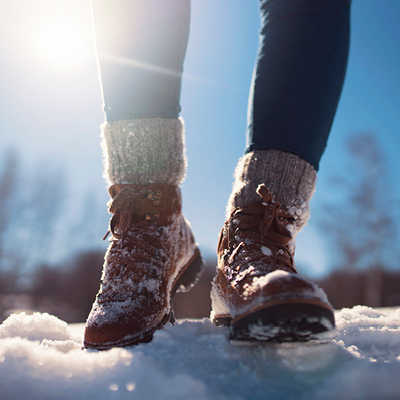Vitality eNews Sign Up
Receive the Summa Health eNewsletter for the latest health tips, advice and updates.
Cold feet: Common winter foot problems and ways to avoid them
Posted December 07, 2020 by Dr. Jacqueline Tulodzieski-Ahlstrom

Winter is upon us — freezing temperatures, snow flurries and whipping winds — and we all know what that means. It’s time to bust out our heavy, winter coats, hats, gloves and scarves to keep us warm on these frigid days. But, don’t forget about your feet, too. It’s important to always wear winter shoes and boots to protect them against the harsh elements.
Lower temperatures can be hard on your extremities, especially your feet. Exposure to cold air causes the body to slow blood circulation to the hands and feet in an effort to preserve the body’s core temperature.
If you’re suffering from painful foot conditions already, cold winter weather can exacerbate them. Patients with poor blood circulation, diabetes and neuropathy are especially prone to winter foot problems.
However, even if you’re not suffering from a foot condition, your risk of developing one increases when temperatures dip.
Cold weather dries out your skin and nails, which weakens them and makes them more susceptible to damage and infection. In addition, if your boots or shoes don’t fit correctly or are tight due to thick socks, the compression can lead to bunions, hammertoes and plantar fasciitis. The constant friction also can cause painful calluses and corns.
Summa Health discusses some of the most common foot problems its providers see each winter so you can avoid winter toe woes this season.
- Toenail fungus. Infection is more common in winter because your nails become dry and brittle. Plus, if your thick socks don’t wick away moisture, your nails become breeding grounds for athlete’s foot and other toenail infections.
- Dry, cracked heels. This is especially common in men and if left untreated, fissures or cracks can develop, increasing your risk of infection.
- Frostbite. When tissue is in freezing temperatures for long periods of time, you can get frostbite. The cold air causes blood vessels to constrict, limiting blood flow to the tissue, which can lead to tissue damage or tissue death.
- Chilblains. Also known as pernio, chilblains are caused by painful inflammation of blood vessels in your skin due to prolonged exposure to cold air. They can cause itching, red patches, swelling and blisters on your hands and feet.
- Raynaud’s Phenomenon. This condition is mostly seen in females with circulation problems. It can develop when toes or fingers are exposed to cold air, causing the small capillaries in your digits to spasm, limiting blood flow to the area. This causes numbness, pain and the skin to turn white or blue.
- Morton’s neuroma and other neuropathy issues. Cold weather can exacerbate neuropathy conditions, often causing weakness, numbness, tingling, burning and pain in the area. Wearing shoes that pinch or constrict your feet also can cause these conditions to flare up.
How to protect your feet this winter
Don’t get cold feet this winter. As temperatures dip, it’s time to increase your foot-care regimen. Summa Health offers 5 ways to protect your feet this winter, so they’re ready for sandal weather at the end of it.
- Make sure your boots fit properly. Feet can change from year to year. Feet tend to get wider as you get older, not to mention gaining weight can cause your feet to get bigger, as well. If your boots don’t fit well this year, replace them.
- Wear shoes with good traction. When heading outside, make sure your shoes have a sole with good traction and a low heel to help prevent slips and falls. Also, make sure your footwear is water-resistant and insulated, which forms a barrier between your feet and the harsh elements.
- Keep your feet clean and dry. Invest in socks that wick away moisture. Also, change your socks regularly to reduce bacteria, especially after exercising.
- Moisturize daily. Seems simple, but many people don’t think about moisturizing their feet. Using a concentrated moisturizer every day on your feet can prevent painful cracks and fissures.
- If your feet hurt, see a doctor. If your feet are in pain, it’s difficult to do any of your normal daily activities, let alone exercise. So, don’t wait. Call your provider to discuss your symptoms.
If you’re experiencing foot pain or notice a problem developing, schedule an appointment with a Summa Health orthopedist by calling 330.835.5533

